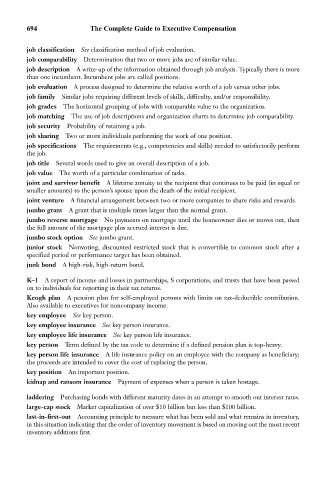Page 709 - Bruce Ellig - The Complete Guide to Executive Compensation (2007)
P. 709
694 The Complete Guide to Executive Compensation
job classification See classification method of job evaluation.
job comparability Determination that two or more jobs are of similar value.
job description A write-up of the information obtained through job analysis. Typically there is more
than one incumbent. Incumbent jobs are called positions.
job evaluation A process designed to determine the relative worth of a job versus other jobs.
job family Similar jobs requiring different levels of skills, difficulty, and/or responsibility.
job grades The horizontal grouping of jobs with comparable value to the organization.
job matching The use of job descriptions and organization charts to determine job comparability.
job security Probability of retaining a job.
job sharing Two or more individuals performing the work of one position.
job specifications The requirements (e.g., competencies and skills) needed to satisfactorily perform
the job.
job title Several words used to give an overall description of a job.
job value The worth of a particular combination of tasks.
joint and survivor benefit A lifetime annuity to the recipient that continues to be paid (in equal or
smaller amounts) to the person’s spouse upon the death of the initial recipient.
joint venture A financial arrangement between two or more companies to share risks and rewards.
jumbo grant A grant that is multiple times larger than the normal grant.
jumbo reverse mortgage No payments on mortgage until the homeowner dies or moves out, then
the full amount of the mortgage plus accrued interest is due.
jumbo stock option See jumbo grant.
junior stock Nonvoting, discounted restricted stock that is convertible to common stock after a
specified period or performance target has been obtained.
junk bond A high-risk, high-return bond.
K–1 A report of income and losses in partnerships, S corporations, and trusts that have been passed
on to individuals for reporting in their tax returns.
Keogh plan A pension plan for self-employed persons with limits on tax-deductible contribution.
Also available to executives for noncompany income.
key employee See key person.
key employee insurance See key person insurance.
key employee life insurance See key person life insurance.
key person Term defined by the tax code to determine if a defined pension plan is top-heavy.
key person life insurance A life insurance policy on an employee with the company as beneficiary;
the proceeds are intended to cover the cost of replacing the person.
key position An important position.
kidnap and ransom insurance Payment of expenses when a person is taken hostage.
laddering Purchasing bonds with different maturity dates in an attempt to smooth out interest rates.
large-cap stock Market capitalization of over $10 billion but less than $100 billion.
last-in-first-out Accounting principle to measure what has been sold and what remains in inventory,
in this situation indicating that the order of inventory movement is based on moving out the most recent
inventory additions first.

